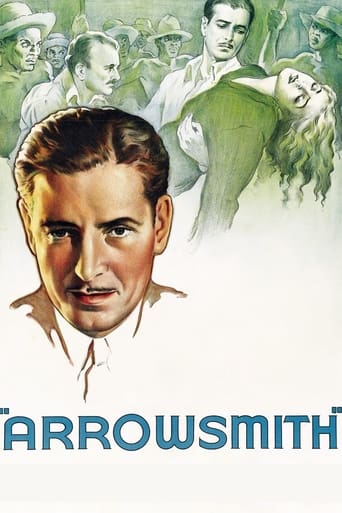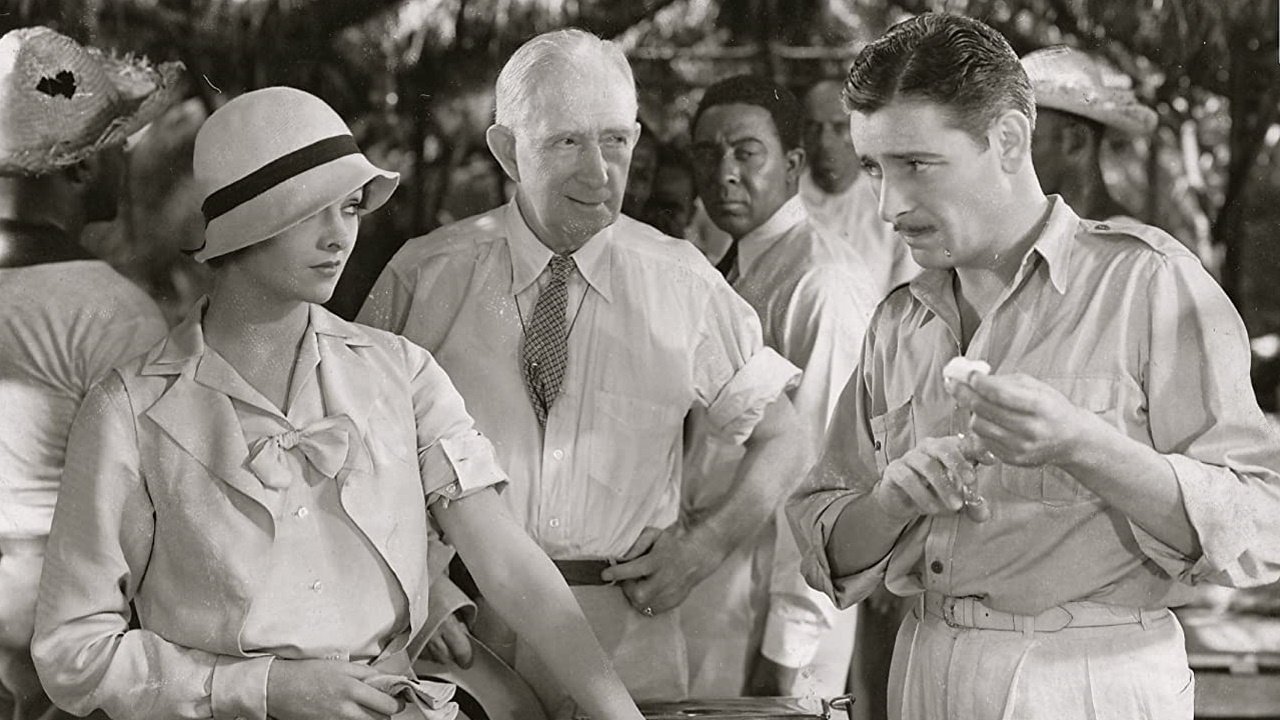Claudio Carvalho
The student of medical school Martin Arrowsmith (Ronald Colman) dreams on becoming a researcher. He seeks out Professor Max Gottlieb (A.E. Anson) that promises the position when Arrowsmith is an undergraduate doctor. Meanwhile Arrowsmith meets the nurse Leora (Helen Hayes) and they fall in love with each other. When Prof. Gottlieb invites Arrowsmith to work with him in New York, he declines since the salary is not enough to support Leora and him. He marries Leora and becomes a countryside doctor. After a while, the frustrated Arrowsmith decides to move with Leora to New York to work with Gottlieb. Soon he is invited to go to a Caribbean Island where there is an outbreak of bubonic plague to test a serum he has developed in the population and Leora decides to go with him despite the danger. Will Arrowsmith succeed in saving the inhabitants? "Arrowsmith" is a deceptive film directed by John Ford. The story seems to be incomplete missing explanation, for example, about Mrs. Joyce Lanyon, performed by the gorgeous Myrna Loy. The relationship between Arrowsmith and his wife is also underdeveloped. Ronald Colman is too old for the role of a young idealistic doctor. Maybe the viewer that has read the novel may like this film more than one that has never read it. Last but not the least, the Brazilian title is awful. My vote is five.Title (Brazil): "Médico e Amante" ("Doctor and Lover")
Robert J. Maxwell
Ronald Coleman is Martin Arrowsmith, a young doctor who has a talent for research but gives up that career to practice medicine in a tiny North Dakota town in order to support his new wife, Helen Hayes.He delivers babies and makes midnight house calls and all that, but he retains his research skills and they lead him to the prestigious McGurk Institute in New York. His mentor is the highly regarded medical researcher, Dr. Gottlieb, played by A. E. Anson.After some years of hard work and neglecting his wife, Coleman discovers a serum that will "kill all the bugs, exterminate them." When he learns of an outbreak of bubonic plague in the West Indies, Dr. Gottlieb urges him to visit the place with his serum and use the scientific method to determine whether it will work. The scientific method, as described here, involves splitting the population of the island in half, then giving one half the serum and withholding the serum from the other half, making comparison possible.Coleman, Hayes, and two other medical friends set up shop on a rainy tropical island where the only medicine the good residents know is voodoo. Coleman manages to save the island's population but at tremendous personal cost.The 1930s, when this appeared, was a time when movies about scientific researchers, particularly in the field of medicine, were being ground out annually. There were biographical films about, oh, I don't know -- just about everybody who was anybody. Pasteur, Koch, Erlich, and Walter Reed come to mind. Often the protagonist was faced with Coleman's dilemma: prove the serum works by being cold blooded or save the victims.Probably such biographies became so common partly because of the enormous popularity of a book about such men, written in 1926 by Paul de Kruif, "Microbe Hunters." It was a best seller for years. De Kruif was a consultant on the movie and added character sketches, although Sinclair Lewis gets the writing credit. I reread the book recently and the style is so antiquated and pompous that there's a laugh on every page.At that, I don't know how de Kruif, a microbiologist, could have let slip a couple of obvious boners. At one point, Coleman refers to bubonic plague as a "virus" when it's caused by bacteria. And he must have known that the scientific method requires an experimental group (the people who get the injections) and a control group (those who don't) but that the two groups don't have to be equal in size. You can reduce the control group to one person out of ten, thereby giving the serum to ninety percent of the population, and you can still make satisfactory comparisons between the two.You'd have a tough time knowing this was directed by John Ford. He doesn't seem to have invested that much of himself in it, but then this was 1931 and he had yet to hit his stride. There are still a few drinking scenes involving booze hidden in a trash can and so forth, and he employs some striking expressionistic effects in the photography.Ronald Coleman is nobody's idea of an American country doctor, but he looks dashing and does a controlled job of filling the role. Helen Hayes -- she's okay too. She isn't staggeringly beautiful but she has a winning voice and a face that doesn't plumb the depths of ugliness. Don't know why her movie career didn't take off. Maybe she just preferred stage work. Myrna Loy appears briefly as Coleman's sympathetic friend. She's radiantly seductive, is as wealthy as Bill Gates, and nice too. At the end, she offers to be his steady date but, instead of jumping her bones then and there on the street, he throws her away and runs off to Vermont to do research with a toothpick and a ball of string. He's going to live in a cabin in the woods with a male friend of his, where, one assumes, they will live on maple syrup and the fruits of love. And he's supposed to be smart.
Steffi_P
Even though only around a third of John Ford's pictures are westerns, it's still undeniable that his forte or, if you prefer, his comfort zone was in historical pictures of some sort. Arrowsmith is unusual in that it is a contemporary drama that Ford both directed and co-produced.In spite of the above, you might think this was indeed a western from the opening scene, in which we see an ancestor of the protagonist as a good ol' covered wagon pioneer. This bit of family history is not brought up again, but it was obviously judged by Ford and Sam Goldwyn to be significant enough to open the film with, even though it would have been one of the most expensive scenes of the shoot (unless that opening shot is lifted from somewhere else, which it may well be). The point seems to be to draw a line between the struggles of the pioneers and the main story of a medical scientist torn between his home life and his career. It seems a rather tenuous comparison.On the other hand, there could be parallels between Dr Arrowsmith and a typical Fordian westerner. Not in the character as written – I'm no auteur theorist – but in the way Ford shoots their environments. In the majority of Ford films he exaggerates the smallness of interiors and the vastness of exteriors. The homestead is safe, yet dull, and the great outdoors is exciting yet dangerous. The village where Arrowsmith practices as a country doctor is shot in much the same way as Ford would a western settlement – cramped interiors, foreground clutter and heavy use of framing. However the medical research centre, while it may be another interior, is shot so as to show off its openness and stark cleanliness, with corridors and waiting rooms so vast they look almost surreal. This is Arrowsmith's "wild west", where he is free to be a pioneer of another sort. Another tenuous comparison? Maybe, but remember directors have many choices of how to shoot a place, regardless of the script or the set design, and these choices will reflect how they view that space and what they feel it means to the story.While Ford's use of space developed incredibly early on, the camera movement at this stage is not yet of the "invisible camera" technique that later became his standard. For those that don't know, invisible camera means you only move the camera when it's following an action, say for example a character walking to the other end of the room. If everyone in the scene is sitting still, the camera sits still. If it's done properly the audience doesn't notice the camera movement, hence "invisible camera". And yet here there is rather a lot of obtrusive camera movement. This is pretty much in line with the general style of the time, in spite of the myth that cameras were immobilised in the early sound era. Despite a few teething problems that were mostly solved by the end of 1929, cameras of the early talkies zipped around just as giddily of those of the late silents.Ford is not known to have given his actors much coaching, nor allow them rehearsals or repeated takes to hone their performance. For this reason the acting in his pictures tends to be only as good as the raw talent of the performers. Ronald Coleman and Helen Hayes were both good dramatic actors, and here they give good – but not outstanding – dramatic performances. Richard Bennett however just gives a fairly standard, slightly comical supporting-player performance as Sondelius, and the part should either have been cast differently or he should have been prompted to play it with more conviction.The story goes that the hard-drinking Ford was contracted by Goldwyn to remain teetotal until the production wrapped. Apparently Ford, eager to get back to the bottle, rushed the shooting even more than usual, tearing pages out of the script wherever he could get away with it. Whether this is true or just another bit of Ford mythology, it certainly makes sense. In particular the love story, crucial to the picture's impact, is massively underdeveloped. Downplaying the romantic angle is actually very typical of Ford, but even the usual Fordian semi-improvised comedy diversions are absent – with the exception of a couple of nice gags in a scene where a boy has his tooth pulled, and an almost surreal moment where a comedy drunk inexplicably wanders on and off the set. The resultant picture is full of great moments, but overall seems a little undernourished. Arrowsmith could have been an intense and poignant drama, but Ford was the wrong man for the job.
tonstant viewer
Goldwyn put together a lot of fine talent here, but none of it jells.Ronald Colman, Laurence Olivier's idol and one of the screen's most likable actors, is just plain miscast. Helen Hayes projects annoyingly to the audience, stage fashion, rather than letting the camera discover her emotions, as even the young Myrna Loy knows how to do. Richard Bennett is enjoyably over-the-top as Sondelius but A. E. Anson's accent is a deal-breaker as Gottlieb (as if there weren't enough real Middle European actors in Hollywood at the time).Sydney Howard's script is condensed to the point of silliness - the other reviewers here who contrast "Gone With the Wind" as a model of condensation are praising an uncredited Ben Hecht, not Sydney Howard. Ray June's fluid cinematography is beautiful throughout, with more than one shot that would wind up re-used in Ford's "The Searchers" many years later.The story is that Goldwyn hired a bibulous Ford on condition that the director couldn't take one drink during production. Helen Hayes noticed that as the shoot progressed, Ford started discarding pages and then whole scenes, in a race to finish the film and get back to his booze. That may be one more reason that the film is barely coherent.Hey, nobody's perfect all the time.


 AD
AD


